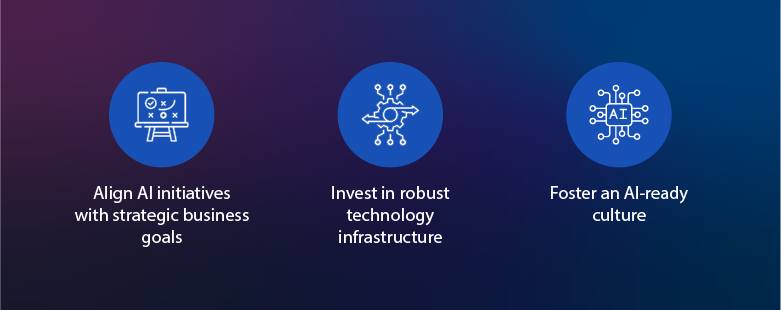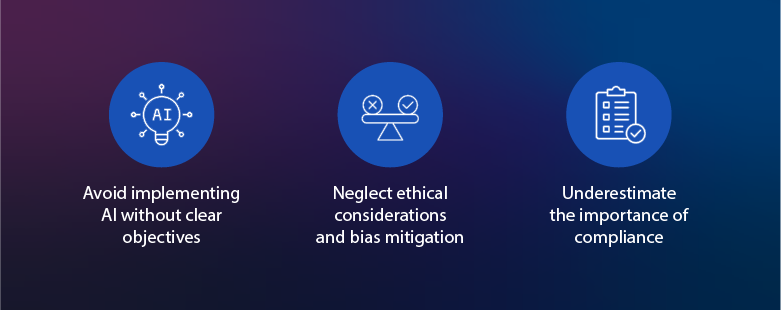Most of the large companies have embarked on the journey of adopting artificial intelligence (AI) technologies, with some pioneering this path more than a decade ago. However, the potential of AI is yet to be fully realized, with only 20% of AI projects succeeding, according to a recent Harvard Business Review article. This underscores the untapped potential and the need for a more strategic approach.
Imagine the possibilities of AI, not just as a technology, but as a transformative force that can revolutionize your business operations and customer experiences. One of the main challenges of AI adoption is not knowing how businesses should and should not use AI. Many companies fail to align AI initiatives with their strategic objectives, causing confusion and inefficiencies. This misalignment can waste significant resources and lead to failed projects. Consider a ship without a rudder – AI without a strategic plan is much the same.
A thoughtful approach to AI can mean the difference between superficial use and achieving substantial, transformative outcomes. An experienced AI consulting services provider can help you in this. This business strategic blueprint aims to guide businesses on how to implement and scale AI effectively through how businesses should and should not use AI. It can thus ensure meaningful impact and sustainable growth. The goal is to move beyond pilot projects and achieve true innovation and efficiency.
How businesses should use AI

01. Align AI initiatives with strategic business goals
AI should be viewed as a tool to achieve specific business objectives, not an end in itself. It’s crucial to start by identifying strategic goals where AI can create a significant impact, such as enhancing customer service, streamlining operations, or driving personalized marketing. Many companies tend to focus too much on the technology rather than its application, leading to misalignment. By aligning AI initiatives with business goals, you can ensure that AI projects drive tangible value and address real pain points within the organization, keeping your business focused and goal oriented.
Without clear alignment, AI projects risk becoming siloed efforts that fail to deliver on their potential. Chief Information Officers (CIOs) and Chief Technology Officers (CTOs) play a crucial role in this alignment. They must prioritize initiatives that directly support the company’s strategic direction, ensuring that AI investments contribute to broader business objectives. This requires a deep understanding of the technology and the business landscape, allowing for informed decision-making and strategic planning.
Consider how Starbucks uses AI to enhance customer experience. Starbucks’ AI-driven personalization engine analyzes customer data to offer personalized recommendations and promotions. Before AI, Starbucks struggled to personalize customer interactions at scale. By leveraging AI, Starbucks has created a more engaging and tailored customer experience, which led to increased customer loyalty and higher sales. Similarly, companies like Netflix and Amazon have successfully used AI to recommend content and products, significantly improving user experience and sales.
Steps for decision-makers:
- Identify key use cases: Conduct a thorough analysis to pinpoint specific business areas where AI can add value. For example, in retail, AI can help optimize inventory management by predicting demand and automating reordering processes.
- Set clear objectives: Define measurable goals for AI projects. For instance, aim to reduce customer churn by 15% through personalized marketing campaigns.
- Measure impact: Establish metrics such as customer satisfaction scores, operational efficiency improvements, and revenue growth to evaluate AI’s contribution to business goals. Regularly review these metrics to ensure alignment with strategic objectives.
Suggested: Want to know more about why AI implementation projects fail and how you can avoid it? Click here!
02. Invest in robust technology infrastructure
Effective AI deployment requires a solid technological foundation. Cloud AI solutions and advanced data storage are essential for supporting AI operations and ensuring scalability. Investing in the right infrastructure early on can prevent costly delays and rework later, providing a sense of security and preparedness. Companies need to ensure their infrastructure can handle AI applications’ data processing and storage demands, which often require significant computational power and advanced data management capabilities.
A solid technological foundation also enables businesses to scale AI solutions efficiently. As AI projects grow from pilots to full-scale implementations, the underlying infrastructure must support increased data volumes and processing requirements. It’s crucial for CTOs to focus on investing in flexible, scalable solutions to ensure that AI initiatives can expand seamlessly as the business grows.
Amazon Web Services (AWS) provides a robust example. Before adopting AI, AWS faced challenges in managing large-scale data and providing personalized services. By investing in a cloud-based AI platform, AWS improved its data management and analysis capabilities, enabling real-time insights and personalized recommendations for customers. This investment led to enhanced operational efficiency and customer satisfaction.
Steps for decision makers like CTOs:
- Assess infrastructure needs: Evaluate current technology infrastructure to identify gaps that could hinder AI deployment. Consider scalability, data storage, and processing capabilities.
- Upgrade systems: Invest in scalable and flexible infrastructure, such as cloud-based solutions, to support AI applications. Ensure the infrastructure can handle large volumes of data and provide the necessary computational power.
- Ensure integration: Seamlessly integrate AI with existing IT ecosystems. For example, integrate AI-driven analytics with customer relationship management (CRM) systems to provide personalized customer interactions.
Suggested: There are more things to consider while adopting AI technologies, whether generative AI or any type. These five are crucial considerations.
03. Foster an AI-ready culture
Cultivating a culture that embraces AI is crucial for successful adoption. Encourage innovation, support experimentation, and view failures as learning opportunities, a key part of the journey to AI readiness. Remember, even Google had its share of failures before becoming AI-ready. Leadership endorsement is vital to drive AI initiatives and foster a culture of continuous improvement. Organizations that nurture an AI-ready culture are more likely to realize the full potential of AI technologies.
Creating an AI-ready culture involves more than just training and education; it requires a shift in mindset across the organization. Employees should feel empowered to explore AI applications, experiment with new ideas, and learn from successes and failures. Leadership plays a crucial role in driving this cultural shift, as they actively champion AI initiatives and demonstrate their commitment to AI-driven transformation, empowering employees to embrace the change.
Consider how Google has created an AI-ready culture. Google promotes a culture of innovation and encourages employees to experiment with AI technologies. Google has successfully integrated AI into its operations by providing resources and support for AI projects, from search algorithms to personalized advertising.
Steps for C-suite executives:
- Promote AI literacy: Educate employees on AI benefits and applications. Offer training programs and workshops to enhance AI literacy across the organization.
- Encourage experimentation: Create a safe environment for testing AI solutions. Allow teams to pilot AI projects and learn from both successes and failures.
- Lead by example: Demonstrate commitment to AI adoption from the top down. Participate in AI initiatives and champion AI-driven projects to inspire confidence and enthusiasm among employees.
Start your AI journey with a clear roadmap
How businesses should not use AI

01. Avoid implementing AI without clear objectives
Rushing into AI projects without defined goals can lead to wasted resources and unmet expectations. AI should address specific business challenges and provide tangible benefits. When AI projects lack clear objectives, they often fail to deliver meaningful results, leading to frustration and skepticism about AI’s potential.
Executives must resist the temptation to implement AI for the sake of innovation alone. Instead, focus on identifying clear, actionable objectives that align with the company’s strategic goals. This approach ensures that AI investments are targeted and effective, driving measurable improvements in key business areas.
For example, a financial services company invested in AI-driven customer service bots without clear objectives. The bots were implemented hastily, leading to customer dissatisfaction due to unresolved issues and impersonal interactions. The company had to revisit its AI strategy, clearly define objectives, and realign the AI deployment to enhance customer service effectively.
Steps for C-suite executives:
- Define objectives: Clearly outline the goals and expected outcomes of AI projects. For instance, aim to improve customer response times by 30% through AI-driven chatbots.
- Prioritize use cases: Stay organized and in control by focusing on areas with the highest potential for impact. Conduct a cost-benefit analysis to prioritize AI initiatives that align with strategic goals.
- Regular reviews: Continuously evaluate AI initiatives to ensure alignment with business goals. Establish review cycles to assess the performance and impact of AI projects.
02. Neglect ethical considerations and bias mitigation
Ignoring ethical implications and biases in AI models can damage brand reputation and trust. Transparency in data and algorithms is crucial for fair and ethical AI deployment. Ethical oversight ensures that AI systems operate fairly and without unintended consequences, such as perpetuating biases or making unjust decisions.
Organizations must implement robust frameworks to govern the ethical use of AI. This includes establishing guidelines for data usage, developing fair algorithms, and conducting regular audits to identify and mitigate biases. By prioritizing ethical considerations, businesses can build trust with stakeholders and avoid potential legal and reputational risks.
For instance, Microsoft faced challenges with its AI-driven chatbot, Tay, which quickly learned and propagated biased and offensive content. This incident highlighted the importance of implementing robust ethical guidelines and monitoring AI systems to prevent biases.
Steps for Chief Risk Officers (CROs):
- Establish ethical guidelines: Implement policies to govern AI ethics. Develop a framework that outlines ethical standards for data usage, algorithm design, and decision-making processes.
- Ensure transparency: Maintain openness in data collection and algorithmic processes. Provide clear documentation and explanations of AI models to stakeholders.
- Mitigate bias: Regularly audit AI models for bias and fairness. Use diverse data sets and implement bias detection tools to identify and address potential biases in AI systems.
03. Underestimate the importance of compliance
Failing to comply with regulatory standards can result in significant legal issues, potentially leading to hefty fines and damage to the company’s reputation. Adherence to data protection laws and industry regulations is non-negotiable. Compliance is not just a legal requirement but a critical aspect of maintaining trust and integrity in AI deployments.
Chief Compliance Officers (CCOs) play a crucial role in ensuring that AI projects are designed to meet relevant regulations. This involves integrating compliance measures into AI development processes and conducting regular audits to verify adherence. By prioritizing compliance, businesses can avoid costly penalties and protect their reputation.
For example, Ireland’s Data Protection Commission imposed 2023’s largest GDPR fine of $1.2 billion on Facebook owner Meta for non-compliance with GDPR. This case underscores the critical importance of strict adherence to compliance standards. In another instance, a startup had to shut down its AI project due to non-compliance with data protection laws, emphasizing the necessity of compliance.
Steps for CCOs:
- Understand regulations: Stay informed about relevant legal and regulatory requirements. Regularly review updates to data protection laws, such as GDPR and CCPA, to ensure compliance.
- Implement compliance measures: Integrate compliance into AI project planning and execution. Conduct regular audits to verify adherence to regulatory standards.
- Continuous monitoring is key to ensuring compliance: Regularly review and update compliance protocols. Establish a compliance team to oversee AI projects and ensure ongoing adherence to legal requirements.
Avoid common AI pitfalls by prioritizing clear objectives, ethical considerations, and regulatory compliance
Overall
Businesses can unlock AI’s full potential by strategically aligning AI initiatives with business goals, investing in the right infrastructure, and fostering an AI-ready culture. Conversely, avoiding the pitfalls of unclear objectives, ethical oversights, and regulatory non-compliance is crucial for long-term success.
In the rapidly evolving AI landscape, a thoughtful and strategic approach will position businesses as leaders in the intelligent technology frontier.









